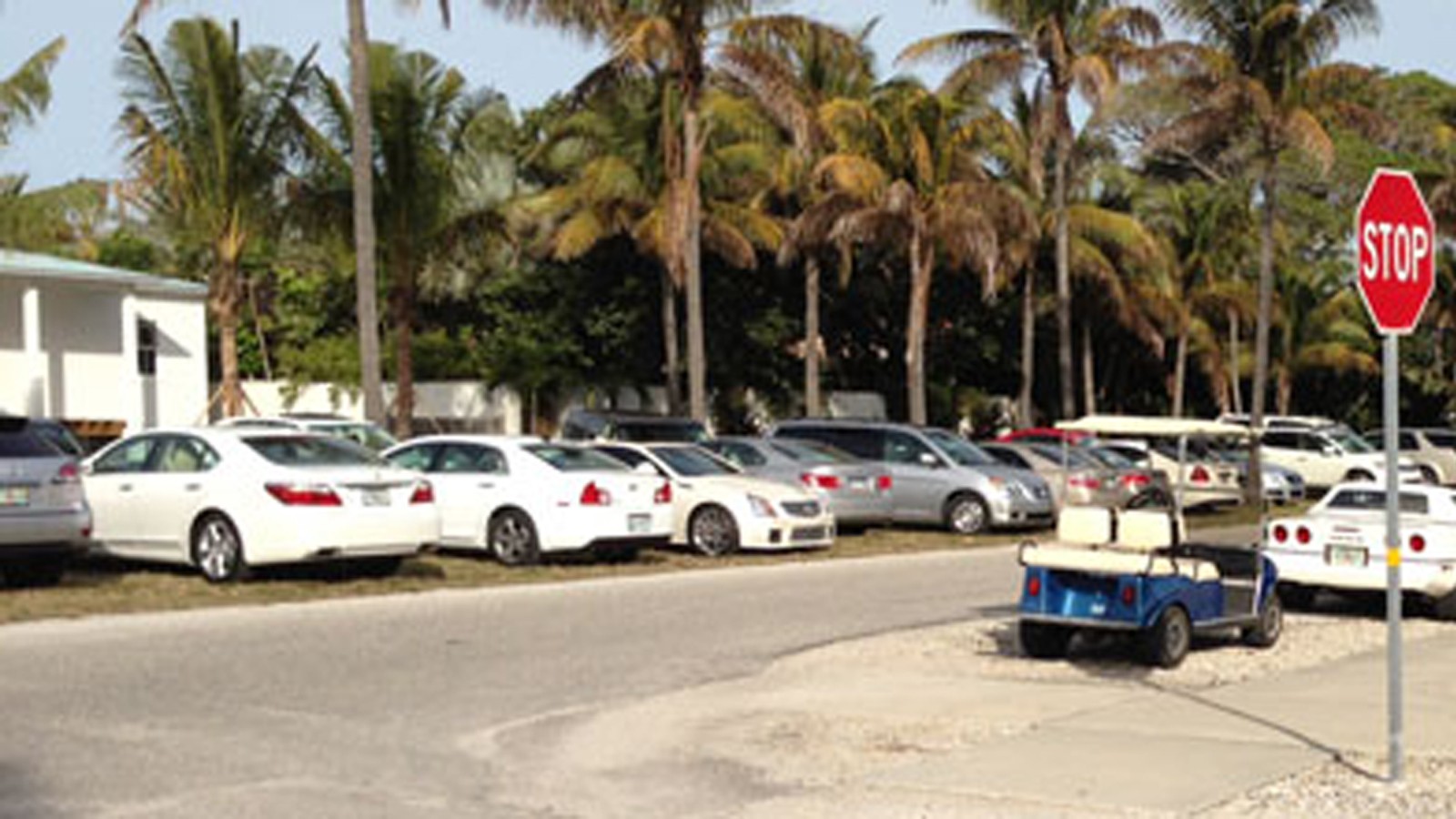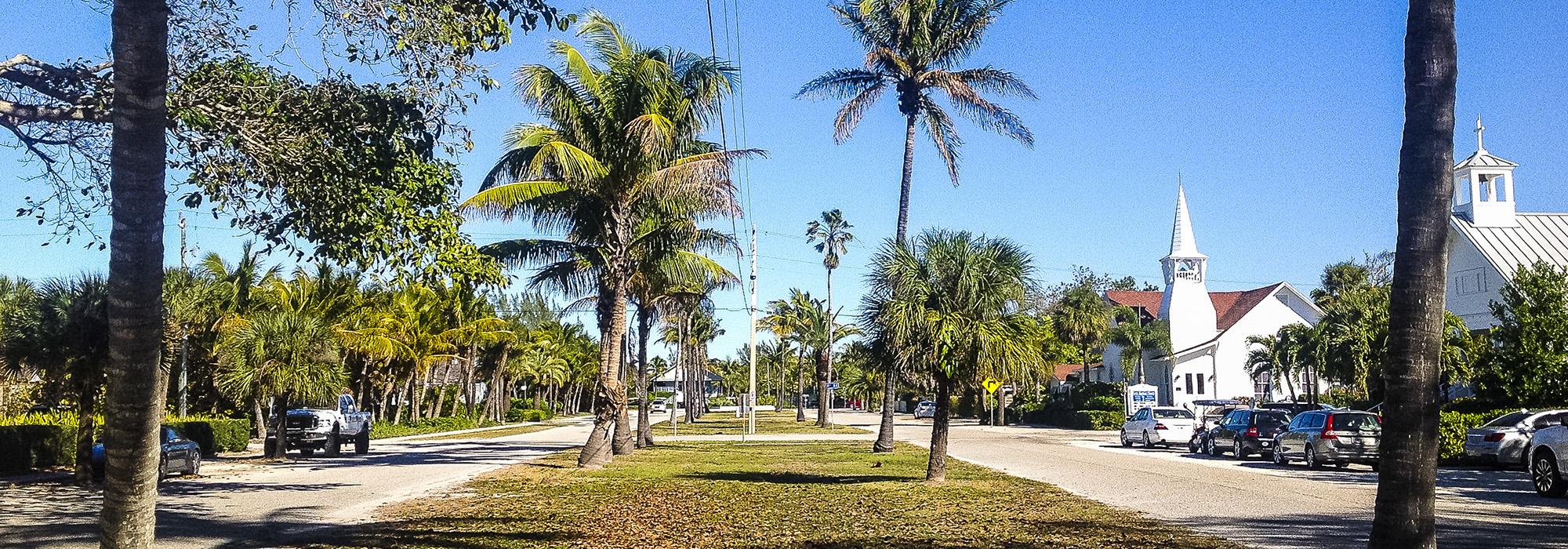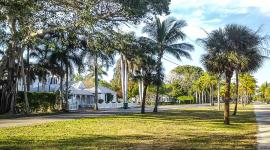Gilchrist Avenue – An Endangered Olmsted-Era Landscape

Located off the southwest coast of Florida on the barrier island of Gasparilla, the town of Boca Grande was formed in 1887 when Albert Gilchrist, future governor of Florida, filed the first plat for a modest six-block development on the southern end of the narrow island. Gilchrist created a broad boulevard running north to south through the center of the town, which he dedicated to himself as Gilchrist Avenue. Gilchrist had been acquiring property on Gasparilla Island since 1880 and by 1905 had accumulated over 500 acres.
History
By the first decade of the new century, Boca Grande's potential drew the attention of the American Agricultural Chemical Company as an ideal location to build a railroad and deep water terminal to ship phosphate from their holdings inland. The company soon entered into a joint venture with Gilchrist and formed the Boca Grande Land Company. In 1910, landscape architect Carl Rust Parker was hired by the Company to develop the island into an elegant four-season resort. A 1911 newspaper account noted that he "is now at work upon plans for laying out streets and the grounds for an immense hotel which will be constructed immediately." Parker, who had worked for the Olmsted firm most of his career but was freelancing at the time, drew up plans for the grounds for the Gasparilla Inn and landscaped the neighboring streets. His subdivision plan established the development of what is now known as the Boca Grande Historic District. The “Parker Plan” shows Gilchrist Avenue as a generous boulevard lined with trees leading to a beachfront pavilion. Gilchrist Avenue was lined with coconut palms and hibiscus, as was Palm Avenue. Second Street between Gilchrist and Park Avenues was lined with Banyans and Fifth Street was lined with casuarinas. The Inn, whose building expansion was designed by architect Francis J. Kennard, opened for guests in the 1912-13 Season. Under the management of Frank Abbot, it soon became a first-class resort.

While the Gasparilla Inn flourished in the 1910s, residential development was restricted to a handful of homes built on or in close proximity to Gilchrist Avenue. Louise du Pont Crowninshield built a cottage on Gilchrist near First Street, and her brother Henry du Pont soon built one nearby. This began what was to become known as the Cottage Colony. Both houses still stand along with a number of other historic homes on the street.
In the early 1920s, a change in management led to a push to take advantage of Florida's land boom to sell off the company's real estate holdings. Clinton Peterkin, fresh off his successful sales campaign at the Mountain Lake development in Lake Wales, Florida, was hired in 1924 to lead the same kind of effort in Boca Grande. Peterkin contacted Olmsted Brothers for the project. In response to the firm's request for a description of the assignment, Peterkin wrote on May 22, 1924, " the property we want to plot is Boca Grande and Gasparilla Island, Florida and the area that is to be plotted at present is about 310 acres," a swath of land amounting to about 30 percent of the island. Peterkin and the company wanted to relocate the railroad away from the narrows and re-plat the property to yield more Gulf front lots. A location for a proposed county road had to be determined and Peterkin also wanted to create a scenic waterway by dredging the length of the Bayou to a depth of seven feet to accommodate launches running from Boca Grande to Placida. The Olmsted firm laid out these consequential changes to the island's topography.
It took a month to negotiate the terms of engagement and on June 25, 1924, Peterkin telegraphed James Frederick Dawson at Olmsted Brothers, "Ready to have you come immediately telegraph me here (Boca Grande) when you can start." The firm assigned William Lyman Phillips who was already in Florida working on the Mountain Lake project to the job. In late September of 1924, and again in March of 1925, Frederick Law Olmsted, Jr. visited Boca Grande. In his detailed trip reports, Olmsted laid out what is now Gasparilla Road, which connects the village to the north end of the island; detailed clearing, dredging, filling, and grooming of the areas east and west of the bayou; and most importantly touched on the advisability of linking the island to the mainland. Olmsted advised against building a highway trestle to allow easier access to the mainland, fearing that the increase in visitors that this would allow would ultimately alter the idyllic character of the community. At the end of his report Olmsted concluded, “The whole architectural question deserves a lot of thought before much is done, except to establish a proper set of safeguarding restrictions to be attached to all future deeds and sales contracts.”

The winter of 1924-25 saw much pressure to begin selling property. A plat of Olmsted's work to date was filed and lithographs were provided to aid in the sales efforts. The Florida land boom had simmered down and the selling season was not successful. This led to an abrupt change in the sales staff and plans to auction off the remaining lots with a new plat. Olmsted returned in March of 1925, and the firm continued to advise on the major ongoing topographical work. The firm left a permanent mark on the development and landscape of the island.
Since the completion of the Boca Grande Land Company’s work, the island has – with the help of many preservation-minded residents and protocols, including the 1980 Gasparilla Island Conservation District Act – avoided overdevelopment, in keeping with Olmsted’s vision and recommendations for the island. Today, new construction must conform to prescribed height restrictions and unit density requirements that retain the community’s scale. To further assure design integrity, the locally constituted Boca Grande Historic Preservation Board exercises architectural review authority over the Historic District. The island boasts a unique heritage left by three renowned landscape architects: Carl Rust Parker, William Lyman Phillips and Frederick Law Olmsted, Jr. In Lee County, Florida, there are 54 sites that have been recognized by the National Register of Historic Places, and ten of those sites are in Boca Grande.
Threat
Gilchrist Avenue lies at the center of Boca Grande's Historic Village. It is the broadest thoroughfare on the island, and at the center of the boulevard is a wide median strip that has served as a two-acre linear park that divides north and south avenues. Historically, the grassy midway which runs the length of the Boulevard was planted with tandem rows of closely spaced coconut palms. This linear expanse extends four blocks and represents the largest public green space in the Historic District. Some of the oldest, most significant homes in town line its course. Its last two blocks frame the western boundary of the downtown area, which was listed in the National Register of Historic Places on August 24, 2011.

Due to pressure from private and commercial interests, in August 2014, the Lee County Department of Transportation made public a proposal to convert this linear park into a parking lot to accommodate 200 vehicles. The intent of the proposal was to alleviate a perceived parking problem that only affects the village during the three-month winter season – parking which could, with ingenuity and community cooperation, be accommodated elsewhere.
Parking on the median has been an ongoing issue. Initially used only for special events and on Sundays, more recently events and social functions have resulted in a near daily congregation of vehicles occupying the park. These have compounded the deterioration by damaging fragile tree root systems, compacting and degrading soils and scarring sod with tire ruts. Parking on the parkway also produces safety concerns. This practice of median parking has been enabled over the last 15 years by the county's failure to replace dead trees and damaged turf and by diminished park maintenance.
While additional parking may support a future tide of day-tripping shoppers and beachgoers, the infrastructure of the town cannot accommodate the growing influx of visitors. Converting the median of a historically significant two-acre boulevard into a parking platform will never satisfy future demand. Instead it will have long-term detrimental consequences for this irreplaceable community asset, rich in historic, scenic and ecological values.
How to Help
The Lee County, Florida, Board of County Commissioners will vote on the proposed Department of Transportation parking plan in the fall of 2014. The voice of a wider constituency will influence this vote. Contact members and ask them to vote "NO" on the DOT plan and encourage these elected officials to restore the median parkway as a commons, as it was envisioned by Parker and Olmsted, Jr.
Emails should be sent to John Manning, Lee Country Commissioner for District One, as well as his colleagues: Cecil Pendergrass, Larry Kiker, Brian Hamman, and Frank Mann.
Lee County Commissioner John Manning, Dist. 1: dist1@leegov.com (239)533-222
Lee County Commissioner Cecil Pendergrass, Dist. 2: dist2@leegov.com (239) 533-222
Lee County Commissioner Larry Kiker, Dist. 3: dist3@leegov.com (239) 533-222
Lee County Commissioner Brian Hamman, Dist. 4: dist4@leegov.com (239) 533-222
Lee County Commissioner Frank Mann, Dist. 5: dist5@leegov.com (239) 533-2225
Please copy the Gilchrist Neighborhood Association on all correspondence to the commissioners at: bbwdjj@aol.com.





